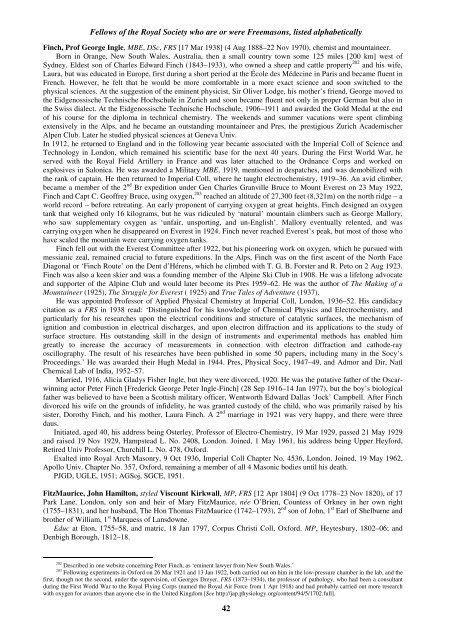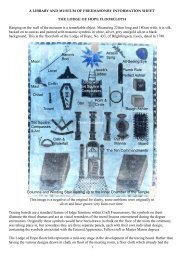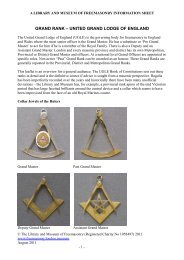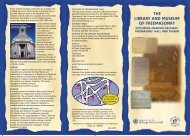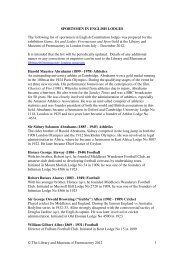FREEMASONS AND THE ROYAL SOCIETY Alphabetical List of ...
FREEMASONS AND THE ROYAL SOCIETY Alphabetical List of ...
FREEMASONS AND THE ROYAL SOCIETY Alphabetical List of ...
You also want an ePaper? Increase the reach of your titles
YUMPU automatically turns print PDFs into web optimized ePapers that Google loves.
Fellows <strong>of</strong> the Royal Society who are or were Freemasons, listed alphabetically<br />
Finch, Pr<strong>of</strong> George Ingle, MBE, DSc, FRS [17 Mar 1938] (4 Aug 1888–22 Nov 1970), chemist and mountaineer.<br />
Born in Orange, New South Wales, Australia, then a small country town some 125 miles [200 km] west <strong>of</strong><br />
Sydney. Eldest son <strong>of</strong> Charles Edward Finch (1843–1933), who owned a sheep and cattle property 202 and his wife,<br />
Laura, but was educated in Europe, first during a short period at the École des Médecine in Paris and became fluent in<br />
French. However, he felt that he would be more comfortable in a more exact science and soon switched to the<br />
physical sciences. At the suggestion <strong>of</strong> the eminent physicist, Sir Oliver Lodge, his mother’s friend, George moved to<br />
the Eidgenossische Technische Hochschule in Zurich and soon became fluent not only in proper German but also in<br />
the Swiss dialect. At the Eidgenossische Technische Hochschule, 1906–1911 and awarded the Gold Medal at the end<br />
<strong>of</strong> his course for the diploma in technical chemistry. The weekends and summer vacations were spent climbing<br />
extensively in the Alps, and he became an outstanding mountaineer and Pres, the prestigious Zurich Academischer<br />
Alpen Club. Later he studied physical sciences at Geneva Univ.<br />
In 1912, he returned to England and in the following year became associated with the Imperial Coll <strong>of</strong> Science and<br />
Technology in London, which remained his scientific base for the next 40 years. During the First World War, he<br />
served with the Royal Field Artillery in France and was later attached to the Ordnance Corps and worked on<br />
explosives in Salonica. He was awarded a Military MBE, 1919, mentioned in despatches, and was demobilized with<br />
the rank <strong>of</strong> captain. He then returned to Imperial Coll, where he taught electrochemistry, 1919–36. An avid climber,<br />
became a member <strong>of</strong> the 2 nd Br expedition under Gen Charles Granville Bruce to Mount Everest on 23 May 1922,<br />
Finch and Capt C. Ge<strong>of</strong>frey Bruce, using oxygen, 203 reached an altitude <strong>of</strong> 27,300 feet (8,321m) on the north ridge – a<br />
world record – before retreating. An early proponent <strong>of</strong> carrying oxygen at great heights, Finch designed an oxygen<br />
tank that weighed only 16 kilograms, but he was ridiculed by ‘natural’ mountain climbers such as George Mallory,<br />
who saw supplementary oxygen as ‘unfair, unsporting, and un-English’. Mallory eventually relented, and was<br />
carrying oxygen when he disappeared on Everest in 1924. Finch never reached Everest’s peak, but most <strong>of</strong> those who<br />
have scaled the mountain were carrying oxygen tanks.<br />
Finch fell out with the Everest Committee after 1922, but his pioneering work on oxygen, which he pursued with<br />
messianic zeal, remained crucial to future expeditions. In the Alps, Finch was on the first ascent <strong>of</strong> the North Face<br />
Diagonal or ‘Finch Route’ on the Dent d’Hérens, which he climbed with T. G. B. Forster and R. Peto on 2 Aug 1923.<br />
Finch was also a keen skier and was a founding member <strong>of</strong> the Alpine Ski Club in 1908. He was a lifelong advocate<br />
and supporter <strong>of</strong> the Alpine Club and would later become its Pres 1959–62. He was the author <strong>of</strong> The Making <strong>of</strong> a<br />
Mountaineer (1925), The Struggle for Everest ( 1925) and True Tales <strong>of</strong> Adventure (1937).<br />
He was appointed Pr<strong>of</strong>essor <strong>of</strong> Applied Physical Chemistry at Imperial Coll, London, 1936–52. His candidacy<br />
citation as a FRS in 1938 read: ‘Distinguished for his knowledge <strong>of</strong> Chemical Physics and Electrochemistry, and<br />
particularly for his researches upon the electrical conditions and structure <strong>of</strong> catalytic surfaces, the mechanism <strong>of</strong><br />
ignition and combustion in electrical discharges, and upon electron diffraction and its applications to the study <strong>of</strong><br />
surface structure. His outstanding skill in the design <strong>of</strong> instruments and experimental methods has enabled him<br />
greatly to increase the accuracy <strong>of</strong> measurements in connection with electron diffraction and cathode-ray<br />
oscillography. The result <strong>of</strong> his researches have been published in some 50 papers, including many in the Socy’s<br />
Proceedings.’ He was awarded their Hugh Medal in 1944. Pres, Physical Socy, 1947–49, and Admor and Dir, Natl<br />
Chemical Lab <strong>of</strong> India, 1952–57.<br />
Married, 1916, Alicia Gladys Fisher Ingle, but they were divorced, 1920. He was the putative father <strong>of</strong> the Oscarwinning<br />
actor Peter Finch [Frederick George Peter Ingle-Finch] (28 Sep 1916–14 Jan 1977), but the boy’s biological<br />
father was believed to have been a Scottish military <strong>of</strong>ficer, Wentworth Edward Dallas ‘Jock’ Campbell. After Finch<br />
divorced his wife on the grounds <strong>of</strong> infidelity, he was granted custody <strong>of</strong> the child, who was primarily raised by his<br />
sister, Dorothy Finch, and his mother, Laura Finch. A 2 nd marriage in 1921 was very happy, and there were three<br />
daus.<br />
Initiated, aged 40, his address being Osterley, Pr<strong>of</strong>essor <strong>of</strong> Electro-Chemistry, 19 Mar 1929, passed 21 May 1929<br />
and raised 19 Nov 1929, Hampstead L. No. 2408, London. Joined, 1 May 1961, his address being Upper Heyford,<br />
Retired Univ Pr<strong>of</strong>essor, Churchill L. No. 478, Oxford.<br />
Exalted into Royal Arch Masonry, 9 Oct 1936, Imperial Coll Chapter No. 4536, London. Joined, 19 May 1962,<br />
Apollo Univ. Chapter No. 357, Oxford, remaining a member <strong>of</strong> all 4 Masonic bodies until his death.<br />
PJGD, UGLE, 1951; AGSoj, SGCE, 1951.<br />
FitzMaurice, John Hamilton, styled Viscount Kirkwall, MP, FRS [12 Apr 1804] (9 Oct 1778–23 Nov 1820), <strong>of</strong> 17<br />
Park Lane, London, only son and heir <strong>of</strong> Mary FitzMaurice, née O’Brien, Countess <strong>of</strong> Orkney in her own right<br />
(1755–1831), and her husband, The Hon Thomas FitzMaurice (1742–1793), 2 nd son <strong>of</strong> John, 1 st Earl <strong>of</strong> Shelburne and<br />
brother <strong>of</strong> William, 1 st Marquess <strong>of</strong> Lansdowne.<br />
Educ at Eton, 1755–58, and matric, 18 Jan 1797, Corpus Christi Coll, Oxford. MP, Heytesbury, 1802–06; and<br />
Denbigh Borough, 1812–18.<br />
202 Described in one website concerning Peter Finch, as ‘eminent lawyer from New South Wales.’<br />
203 Following experiments in Oxford on 26 Mar 1921 and 13 Jan 1922, both carried out on him in the low-pressure chamber in the lab, and the<br />
first, though not the second, under the supervision, <strong>of</strong> Georges Dreyer, FRS (1873–1934), the pr<strong>of</strong>essor <strong>of</strong> pathology, who had been a consultant<br />
during the First World War to the Royal Flying Corps (named the Royal Air Force from 1 Apr 1918) and had probably carried out more research<br />
with oxygen for aviators than anyone else in the United Kingdom [See http://jap.physiology.org/content/94/5/1702.full].<br />
42


